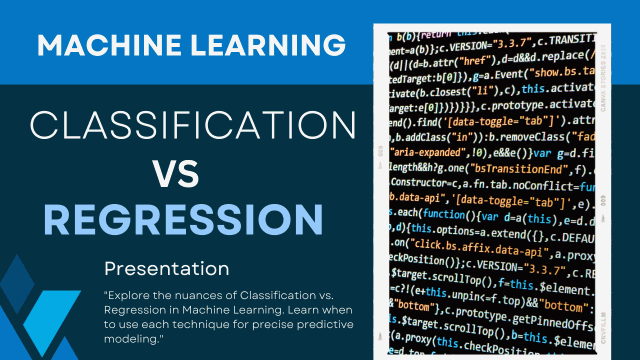Classification vs. Regression in Machine Learning: Learn the Differences
Preface
In the realm of machine learning, two fundamental paradigms emerge as crucial tools for predictive modeling: classification and regression. These methodologies serve distinct purposes, and selecting the appropriate one hinges on the nature of the problem at hand.

In this comprehensive tutorial, we delve deep into the classification vs. regression in machine learning, providing you with the insights needed to make informed decisions in your data-driven endeavors.
I. Classification: Categorizing Data with Precision
A. Definition and Purpose
Classification, at its core, is the process of assigning predefined categories or labels to data points based on their features. It serves the purpose of distinguishing between different classes or groups within a dataset.
This technique finds extensive applications in scenarios where the goal is to categorize data into discrete groups, such as email filtering, image recognition, sentiment analysis, and medical diagnoses.
B. Algorithms and Techniques
Decision Trees
A versatile algorithm that partitions data based on feature attributes to create a tree-like structure for classification.

Decision trees are particularly effective in scenarios where interpretability is crucial. They offer a distinct visual depiction of the process of making decisions.
A powerful algorithm that creates a hyperplane to separate classes in high-dimensional space. SVMs are known for their effectiveness in complex, non-linear classification tasks.
K-Nearest Neighbors (KNN)
Classifies data points based on the majority class among their k-nearest neighbors. KNN is a versatile algorithm suitable for both small and large datasets.
Despite its name, logistic regression is a classification algorithm used for binary classification problems. It forecasts the likelihood that a specific input is a member of a particular class. Logistic regression is widely used in fields like medicine, economics, and marketing.
Decision Trees (Continued)
Decision trees can also be used for classification tasks. They divide the feature space into regions, each corresponding to a different class.
C. Evaluation Metrics
To assess the performance of a classification model, several metrics come into play, including accuracy, precision, recall, F1-score, and ROC-AUC. These metrics provide a quantitative measure of how well the model is classifying the data.
D. Advantages of Classification
Interpretability: Decision trees, for instance, offer a clear and interpretable model that allows for easy understanding of the classification process.
Applicability in Text Analysis: Classification is widely used in sentiment analysis, topic modeling, and text categorization.
II. Regression: Predicting Continuous Values with Accuracy
A. Definition and Purpose
Regression, on the other hand, is geared towards predicting continuous numerical values based on input features. It aims to establish a functional relationship between the independent variables and the dependent variable.
This method proves invaluable in scenarios such as predicting house prices, sales forecasts, temperature trends, and financial modeling.
B. Algorithms and Techniques
Linear Regression
Models the relationship between the dependent variable and one or more independent variables using a linear equation.

Linear regression provides a straightforward approach to modeling relationships between variables. It’s commonly applied in financial and economic-related sectors.
Random Forest Regression
Utilizes an ensemble of decision trees to enhance prediction accuracy. This technique is robust and effective in handling complex, non-linear relationships.
Adapts the principles of SVM for regression tasks. SVR is particularly useful in scenarios where the relationship between variables is non-linear.
Ridge Regression
Ridge regression introduces L2 regularization, aiming to prevent overfitting by keeping coefficients as small as possible. It’s valuable when dealing with datasets that have a high degree of multicollinearity.
Lasso regression introduces L1 regularization, driving some coefficients to zero, effectively performing feature selection. It’s valuable in situations with a large number of features.
Elastic Net Regression
Elastic Net Regression combines the strengths of both lasso and ridge regression by using a hybrid approach. It’s particularly useful in scenarios with high multicollinearity and a large number of features.
C. Evaluation Metrics
Regression models are evaluated using metrics such as the mean absolute error (MAE), mean squared error (MSE), root mean squared error (RMSE), and R-squared (R2) score. These metrics provide valuable insights into the predictive performance of the model.
D. Advantages of Regression
Continuous Predictions
Regression provides precise numerical predictions, making it ideal for scenarios where exact values are crucial.
Extrapolation Capabilities
Regression models can be extended to predict values beyond the range of the training data, allowing for informed decision-making in unforeseen circumstances.
III. Choosing Between Classification and Regression
A. Considerations
Nature of the Target Variable
Is the target variable categorical (classification) or continuous (regression)?
What is the ultimate goal of the predictive model? Is it to classify or predict numerical values?
Data Characteristics
Understanding the distribution and nature of the dataset is pivotal to making the right choice.
B. Case Studies
Illustrative examples showcase scenarios where either classification or regression proves to be the optimal approach.
IV. Frequently Asked Questions (FAQs)
Q1. What are some common applications of classification models?
A1. Classification models are extensively used in various domains, including email filtering, image recognition, medical diagnosis, and sentiment analysis in natural language processing.
Q2. How do I know whether to use regression or classification for my dataset?
A2. Consider the nature of your target variable. If it’s categorical and requires grouping into classes, opt for classification. If you need to predict continuous numerical values, regression is the appropriate choice.
Q3. Can I use a combination of classification and regression in a single predictive model?
A3. Yes, ensemble methods like gradient boosting and random forests often combine both classification and regression models to improve overall predictive performance.
V. Conclusion
In conclusion, mastering the art of selecting between classification and regression is pivotal in the realm of machine learning. Each technique brings its own strengths to the table, tailored for specific data-driven objectives.
By considering the nature of the target variable, the business goal, and the characteristics of the dataset, you can make an informed decision that leads to accurate and meaningful predictions.
Remember, the key lies not only in the algorithm but also in understanding the problem domain and the nuances of the data at hand. Armed with this knowledge, you are poised to embark on successful predictive modeling endeavors.
Get access all prompts: https://bitly.com/machinelearning







